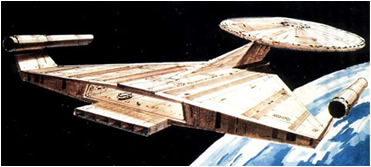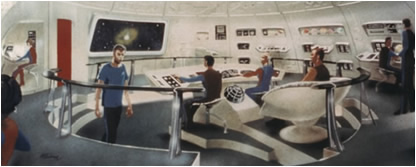| |



 |
|
After several attempts to bring Star
Trek to the screen, in 1977 Paramount decided to produce a second television
series, appropriately titled Star Trek: Phase II. Barry Diller, at the
time president of Paramount, had grown concerned by the direction in which
Star Trek had been taken in the latest movie script - Planet of the
Titans, by Chris Bryant and Allan Scott. After the film had been
canceled in preproduction, Diller had gone to Gene Roddenberry and suggested
it was time to take Star Trek back to its original context - a television
series.
Though Paramount was at fisrt reluctant
to put aside the development work that had been undertaken for the canceled
movie, Roddenberry wanted to reunite as many members of his original
production team as possible and start the design process again. These
paintings were part of that process, giving us a glimpse of one possible
Star Trek that never was.
 
Ralph McQuarrie is best known to the public for his stunning
production designs for the Star Wars films. His imagination helped guide the
final appearance of Darth Vader and his storm troopers, and he also created
many of the matte paintings of planets and satellites that appeared in the
film. After Star Wars wrapped in 1977, McQuarrie was invited to England to
work under Ken Adam to help develop the designs for a new Star Trek movie,
ultimately abandoned to make way for STar Trek: Phase II, the television
series. Their Enterprise-design,
however, was abandoned, and Roddenberry asked Matthew Jefferies to update
the famous starship to reflect the refit that would be part of the series'
backstory. Jefferies' redesign changed the engine nacelles from tubes to
thun, flat-sided modules, and tapered their supports. He also added the
distinctive photon torpedo ports on the saucer connector.

Unlike the first redesign of the Enterprise, Jefferies' new
version was built this time by Don Loos, who had built the original ship for
the original series. But when Paramount abandoned its plans to create a
fourth television network and subsequently transformed the second Star Trek
series into the first movie, that Enterprise was packed away as movie
director Robert Wise brought in a new art director - Harold Michaelson - who
started a second redesign of the ship, essentially keeping Jefferies' new
lines, while adding the extensive detail that was necessary for a
motion-picture miniature.

Mike Minor, who had provided many of the wall paintings seen
in the original series, as well as having designed the Melkotian from "Spectre
of the Gun", and the Tholian web, part of the Emmy-Award-winning visual
effects in the episode of the same name, also returned to contribute to the
updating and redesign of the series. Jim Rugg, another veteran from the
first season of the original Star Trek, was brought back to be in charge of
special effects. Mike Minor's
initial designs for the new Star Trek series are clearly the evolutionary
step between the original series and The Motion Picture. The bridge-wall
control modules survived almost intact to The Motion Picture (note the
holographic starmap projector in front of the captain's chair), while the
transporter room is essentially a redress of the original set with a more
streamlined console and new all displays. The recreation room concepts, also
by Mike Minor, show several crewmembers playing
some kind of anti-gravitational game, and some engaging in intimate
conversation.

As early as the original series' third season, Gene
Roddenberry had spoken of making a Star Trek motion picture. At the 1968
World Science Fiction Convention held over the Labor Day weekend in Oakland,
California, he drew enthousiastic applause when he told a rapt audience his
plans for filming a prequel to the series, telling the story of how Kirk and
his crew had met at Starfleet Academy. For that weekend at least, Star Trek
was on a roll. But the Tuesday after Labor Day, the real world intruded and
kept the opening of the first Star Trek movie at bay for more than a decade.
Yet the idea of a movie continued as Roddenberry's dream
throughout that decade, sometimes coming tantalizingly close to becoming
reality, only to be snatched away by the capriciousness of Hollywood deal
making. In the spring of 1975, Paramount entered into a deal with
Roddenberry in which he would write the script for a low-budget Star Trek
feature, tentatively to cost between two to three million dollars.
When Roddenberry delivered his script - The God Thing
- in August on that year, Barry Diller, the president of Paramount, rejected
it, but asked Roddenberry to write another. At the same time, the studio
also invited other writers, cinluding Harlan Ellison, Robert Silverberg and
Star Trek veteran John D.F. Black, to try their hand at pitching a suitable
story. In the meantime, Gene Roddenberry went backt to work on a second
script, this time with cowriter Jon Povill. Once again, Paramount passed.
But despite the trouble they were having finding a script, the studio's
interest in making a Star Trek movie continued to grow.

All material may be reproduced
under the Terms of Usage outlined in the legal
disclaimer. Simply stated, this means appropriate credit must be given in the form of a hyperlink.
For any content used by courtesy of a third party,
this third party is to be credited. |
|
|
 |
![]()